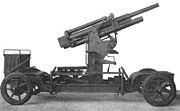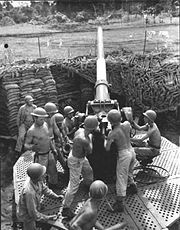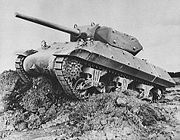
3-inch M1918 gun
Encyclopedia

World War II
World War II, or the Second World War , was a global conflict lasting from 1939 to 1945, involving most of the world's nations—including all of the great powers—eventually forming two opposing military alliances: the Allies and the Axis...
. The M1918 was later adapted for the anti-tank role, serving as the main armament of the M10 tank destroyer during World War II.
The predecessor : 3-inch M1917
The 3-inch M1917 was the US's first dedicated anti-aircraft gun, entering service during World War IWorld War I
World War I , which was predominantly called the World War or the Great War from its occurrence until 1939, and the First World War or World War I thereafter, was a major war centred in Europe that began on 28 July 1914 and lasted until 11 November 1918...
. Only a few were built, as the similar 3-inch M1918 on a mobile mount was considered more useful and was produced in large numbers.
Development of the M1917 started in 1915, and as the name implies, took two years to enter service. The gun was essentially an unmodified 3-inch M1903 (76.2 mm L/55) coastal-defense gun on a new mount allowing it to be aimed to high elevations. A number were used during the war. In the immediate post-war era it was developed as the 3-inch M3, using a removable barrel liner. In 1928 it was further improved in the 3-inch M3 by using a thicker removable liner that eased manufacturing.
History of the 3-inch M1918


For mobile use the original coastal gun was too heavy, so a smaller version was developed as the 3-inch M1918. For this role the barrel was cut down in length, to 50 calibers from 55, and a new breech was introduced to fire smaller rounds (76.2x585R, 212 cubic inches instead of 76.2x690R, 293 cubic inches). Like the adaptation that created the M2, the M1918 was also fitted with a removable liner in 1928, becoming the 3-inch M3. Another upgrade was started in 1931 as the T8, and then T9, but these projects were cancelled in 1938 when the 90 mm gun
90 mm gun
The American 90 mm family of guns served as primary heavy anti-aircraft and anti-tank guns, playing a role similar to the renowned German 88 mm gun. They were the US's primary anti-aircraft guns from just prior to the opening of World War II into the 1950s when most AAA was replaced by missile...
was selected in their place.
In September 1940 a project started to adapt the 3-inch gun to the anti-tank role, starting with the T9 experimental model but equipping it with the breech, recoil system and carriage borrowed from the 105mm M2
M101 howitzer
The 105 mm M2A1 howitzer was the standard light field howitzer for the United States in World War II, seeing action in both European and Pacific theaters. Entering production in 1941, it quickly entered the war against the Imperial Japanese Army in the Pacific, where it gained a reputation...
howitzer. The gun was accepted for service as the 3-inch M5.
A similar derivative of the T9 - the 3-inch M6 - was intended to be mounted on the M5 self-propelled gun, which was eventually abandoned. A final adaptation was the 3-inch M7, which included minor modifications for mounting on the M10 Wolverine
M10 Wolverine
The M10 tank destroyer, formally 3-inch Gun Motor Carriage, M10 was a United States tank destroyer of World War II based on the chassis of the M4 Sherman tank. It was numerically the most important U.S...
. M7 saw wide use although it was supplanted to some extent by more powerful weapons such as the 90mm M3
90 mm gun
The American 90 mm family of guns served as primary heavy anti-aircraft and anti-tank guns, playing a role similar to the renowned German 88 mm gun. They were the US's primary anti-aircraft guns from just prior to the opening of World War II into the 1950s when most AAA was replaced by missile...
and the British QF 17 pounder. 6,824 M7 guns were manufactured.
Variants
- M1917M1917Under the old Model-year nomenclature system many different Pieces of equipment had the same Model number.* M1917 bayonet, the bayonet used with the US M1917 Enfield rifle and later with US Army combat shotguns* M1917 Trench knife...
- Original fixed-place anti-aircraft gun introduced in 1917. - M1918 - Mobile anti-aircraft gun using a cut-down version of the original M1917 gun and a new mount.
- M1 - Variant of the M1918 with a removable barrel liner.
- M2 - Variant of the M1917 with a removable barrel liner.
- M3 - Variant of the M1918 with a removable barrel liner.
- M4 - Version of the M2 with a thicker liner for easier manufacturing.
- M5 - Version of the T9 adapted for anti-tank use.
- M6 - Version of the T9 as mounted in the 3in Gun Motor Carriage M5.
- M7 - Version of the M5 for use on the 3in Gun Motor Carriage M10M10 WolverineThe M10 tank destroyer, formally 3-inch Gun Motor Carriage, M10 was a United States tank destroyer of World War II based on the chassis of the M4 Sherman tank. It was numerically the most important U.S...
.
Self-propelled mounts
- Heavy Tank M6M6 Heavy TankThe Heavy Tank M6 was an American heavy tank designed during World War II. The tank was produced in small numbers and never saw combat.-History and description:...
(M7 gun in mount T49). - 3in Antiaircraft Gun Carriage T1 (Garford 7½ ton 6x4 truck chassis).
- 3in Gun Motor Carriage T1 / M5 (high speed tractor M2 chassis, M6 gun).
- 3in Gun Motor Carriage T7 (Trackless Tank chassis).
- 3in Gun Motor Carriage T15 (Ford 4x4 / 6x6 truck chassis).
- 3in Gun Motor Carriage T20 (Light Tank M3Stuart tankThe M3 Stuart, formally Light Tank M3, was an American light tank of World War II and supplied to British and Commonwealth forces under lend-lease prior to the entry of the U.S. into the war—and used thereafter by U.S...
chassis). - 3in Gun Motor Carriage T24 (Medium Tank M3 chassis, M3 gun).
- 3in Gun Motor Carriage T35 / M10M10 WolverineThe M10 tank destroyer, formally 3-inch Gun Motor Carriage, M10 was a United States tank destroyer of World War II based on the chassis of the M4 Sherman tank. It was numerically the most important U.S...
(M4 ShermanM4 ShermanThe M4 Sherman, formally Medium Tank, M4, was the primary tank used by the United States during World War II. Thousands were also distributed to the Allies, including the British Commonwealth and Soviet armies, via lend-lease...
chassis, M7 gun in mount M5). - 3in Gun Motor Carriage T40 / M9 (Medium Tank M3 chassis, M1918 gun).
- 3in Gun Motor Carriage T50.
- 3in Gun Motor Carriage T55T55E1 Motor CarriageThe T55E1 3-inch Gun Motor Carriage was a prototype vehicle developed by the Allied Machinery Manufacturing Company in 1943 for the US Army. An eight wheel drive vehicle, the T55E1 was armed with one three-inch gun in a limited traverse mounting and a supporting .50 caliber machine...
. - 3in Gun Motor Carriage T56, T57 (Light Tank M3A3Stuart tankThe M3 Stuart, formally Light Tank M3, was an American light tank of World War II and supplied to British and Commonwealth forces under lend-lease prior to the entry of the U.S. into the war—and used thereafter by U.S...
chassis, M7 gun).
See also
- List of anti-aircraft guns
- G-numbers
External links
- "Fast Motorized Guns With Steel Brains - Built To Hunt Planes In Next War" Popular Mechanics, March 1930, pp 458-459
- United States. Army. Ordnance Dept, "Handbook of artillery : including mobile, anti-aircraft and trench matériel", May 1920. See "3-Inch Anti-Aircraft Gun, Model 1918" Pages 326–339
- Training Air Defense August 1940 Popular MechanicsPopular MechanicsPopular Mechanics is an American magazine first published January 11, 1902 by H. H. Windsor, and has been owned since 1958 by the Hearst Corporation...
article on 3-inch M3 coastal defense unit - M5 & M7 armor penetration table
- http://www.archive.org/details/americasmunitio01deptgoog World War I material statistics, and pics.
- https://www.bliss.army.mil/Museum/fort_bliss_museum.htm only survivor located here.

